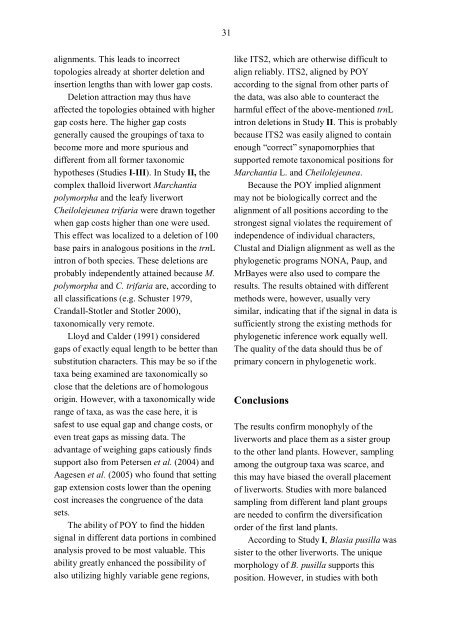Evolutionary relationships of liverworts with a special focus ... - Doria
Evolutionary relationships of liverworts with a special focus ... - Doria
Evolutionary relationships of liverworts with a special focus ... - Doria
Create successful ePaper yourself
Turn your PDF publications into a flip-book with our unique Google optimized e-Paper software.
31<br />
alignments. This leads to incorrect<br />
topologies already at shorter deletion and<br />
insertion lengths than <strong>with</strong> lower gap costs.<br />
Deletion attraction may thus have<br />
affected the topologies obtained <strong>with</strong> higher<br />
gap costs here. The higher gap costs<br />
generally caused the groupings <strong>of</strong> taxa to<br />
become more and more spurious and<br />
different from all former taxonomic<br />
hypotheses (Studies I-III). In Study II, the<br />
complex thalloid liverwort Marchantia<br />
polymorpha and the leafy liverwort<br />
Cheilolejeunea trifaria were drawn together<br />
when gap costs higher than one were used.<br />
This effect was localized to a deletion <strong>of</strong> 100<br />
base pairs in analogous positions in the trnL<br />
intron <strong>of</strong> both species. These deletions are<br />
probably independently attained because M.<br />
polymorpha and C. trifaria are, according to<br />
all classifications (e.g. Schuster 1979,<br />
Crandall-Stotler and Stotler 2000),<br />
taxonomically very remote.<br />
Lloyd and Calder (1991) considered<br />
gaps <strong>of</strong> exactly equal length to be better than<br />
substitution characters. This may be so if the<br />
taxa being examined are taxonomically so<br />
close that the deletions are <strong>of</strong> homologous<br />
origin. However, <strong>with</strong> a taxonomically wide<br />
range <strong>of</strong> taxa, as was the case here, it is<br />
safest to use equal gap and change costs, or<br />
even treat gaps as missing data. The<br />
advantage <strong>of</strong> weighing gaps catiously finds<br />
support also from Petersen et al. (2004) and<br />
Aagesen et al. (2005) who found that setting<br />
gap extension costs lower than the opening<br />
cost increases the congruence <strong>of</strong> the data<br />
sets.<br />
The ability <strong>of</strong> POY to find the hidden<br />
signal in different data portions in combined<br />
analysis proved to be most valuable. This<br />
ability greatly enhanced the possibility <strong>of</strong><br />
also utilizing highly variable gene regions,<br />
like ITS2, which are otherwise difficult to<br />
align reliably. ITS2, aligned by POY<br />
according to the signal from other parts <strong>of</strong><br />
the data, was also able to counteract the<br />
harmful effect <strong>of</strong> the above-mentioned trnL<br />
intron deletions in Study II. This is probably<br />
because ITS2 was easily aligned to contain<br />
enough “correct” synapomorphies that<br />
supported remote taxonomical positions for<br />
Marchantia L. and Cheilolejeunea.<br />
Because the POY implied alignment<br />
may not be biologically correct and the<br />
alignment <strong>of</strong> all positions according to the<br />
strongest signal violates the requirement <strong>of</strong><br />
independence <strong>of</strong> individual characters,<br />
Clustal and Dialign alignment as well as the<br />
phylogenetic programs NONA, Paup, and<br />
MrBayes were also used to compare the<br />
results. The results obtained <strong>with</strong> different<br />
methods were, however, usually very<br />
similar, indicating that if the signal in data is<br />
sufficiently strong the existing methods for<br />
phylogenetic inference work equally well.<br />
The quality <strong>of</strong> the data should thus be <strong>of</strong><br />
primary concern in phylogenetic work.<br />
Conclusions<br />
The results confirm monophyly <strong>of</strong> the<br />
<strong>liverworts</strong> and place them as a sister group<br />
to the other land plants. However, sampling<br />
among the outgroup taxa was scarce, and<br />
this may have biased the overall placement<br />
<strong>of</strong> <strong>liverworts</strong>. Studies <strong>with</strong> more balanced<br />
sampling from different land plant groups<br />
are needed to confirm the diversification<br />
order <strong>of</strong> the first land plants.<br />
According to Study I, Blasia pusilla was<br />
sister to the other <strong>liverworts</strong>. The unique<br />
morphology <strong>of</strong> B. pusilla supports this<br />
position. However, in studies <strong>with</strong> both
















